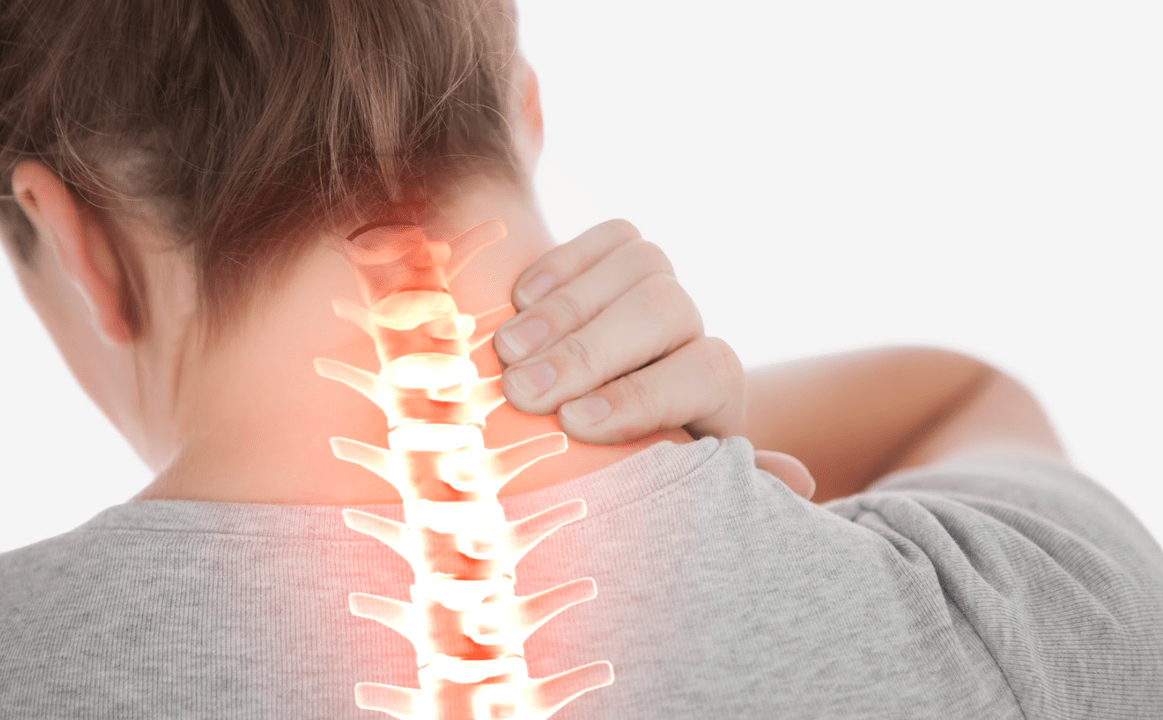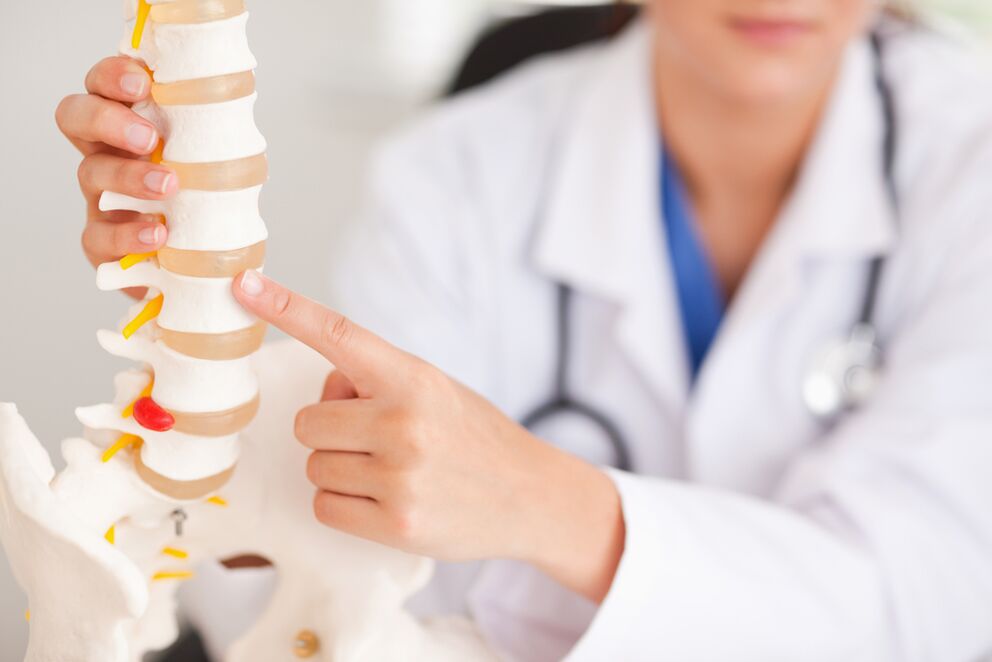Osteochondrosis is a degenerative-destructive lesion of the spine, which includes the defeat of vertebrae bodies, joint apparatus, ligament apparatus and intervertebral discs. This disease is commonly uniformly in all countries - from 45 to 85% of the population suffers from this disease. The onset of osteochondrosis occurs in patients over 30 to 35 years old, however, cases of previous beginning of the disease are known. Men and women get sick with approximately the same frequency.
Causes

There is no unified cause for the development of osteochondrosis. There are a large number of predisposing causal factors. The main ones are as follows:
- Lesions in the spine (fractures, bruises, displacements);
- Hereditary predisposition;
- Foot diseases causing a spine overload - this includes flat feet, varied foot deformation, valg deformation of the foot;
- Wearing close and uncomfortable shoes for a long time (also causes spinal overload);
- Overweight and obesity;
- Age -related changes;
- Sedentary lifestyle;
- Athletes who abruptly abandon their training and classes;
- Metabolic disorders;
- Spinal curvature (kyphosis, lordosis, scoliosis);
- Professional Resources - Weight survey, curves and frequent shoots of the body, work in an uncomfortable body position;
- Frequent and prolonged hypothermia;
- Stress;
- A specific climate, both at the place of residence and at the workplace - low air temperatures and high humidity.
When exposed to one or more causal factors, the development of the disease begins. It is customary to divide it into four main stages:
- The first stage. There is a decrease in the amount of moisture in the core of the intervertebral disc, it becomes flatter, the distance between the vertebrae decreases. The cartilage is covered with small cracks.
- The second stage. Due to the reduction in the distance between the vertebrae, the muscle and the vertebra ligament apparatus occurs. This leads to the pathological mobility of vertebral bodies, to their displacements.
- The third stage. Due to progressive processes in the spine, squeezing (protrusion) of intervertebral discs, subluxation of vertebrae occurs.
- The fourth stage. Among the vertebrae, bone peaks appear (osteophytes), which aim to eliminate the mobility of the vertebrae, the prevention of dislocations. Over time, there are so many of them that affected vertebrae completely lose their mobility. In this case, there is a trauma of blood vessels and nerves passing near the vertebrae and leaving the spine spine.
In the first and last stages of clinical manifestations (pain), the patient does not have.
Classification
There are many osteochondrosis classifications. Each doctor chooses the most acceptable to himself. The following classifications are used more often:
Classification in the column defeat:
- Cervical osteochondrosis;
- Thoracic osteochondrosis;
- Lumbar osteochondrosis;
- Crowned osteochondrosis;
- Extensive osteochondrosis (common) - affects 2 or more spine.
Classification by the degree of change in the intervertebral disc (radiological stages):
- 0 Internship - There is no disk change;
- 1st stage - small changes, including maximum internal tears;
- 2 Stages - Severe changes on the disk, keeping the outer surface;
- Stage 3 The entire disc is completely affected (cracks scattered to the outer surface, squeezing the disc under the bodies of the vertebrae, etc. ).
Classification by clinical manifestations and degree of operation impaired:
- 1st Internship - The operation of the spine is not altered, the patient feels a slight pain in the lesion;
- 2 Stages - The functioning of the spine is disturbed (there are sublxuses of the vertebral bodies, disc protrusion, nerve pinches), pain of destruction intensifies;
- Step 3 - The column is deformed, intervertebral disc hernias occur, significant pain;
- Stage 4 - It is difficult to move the patient, the mobility of the spine decreases, the pain during the lowest movement. The patient receives disability.
Osteochondrosis symptoms

The symptoms of osteochondrosis depends on the area of damage to the spine and the degree of disorders that occur in it.
For the expanded clinical image of cervical spine osteochondrosis, the following signs are characteristic:
- Violation of visual acuity;
- Dizziness;
- Tinnitus;
- "Flies" flashing in front of the eyes and the appearance of colorful points;
- Hearing loss;
- Headache in the NAPE region, temporal and parietal, intensifying by moving the cervical spine;
- Loss of consciousness;
- Snoring;
- Hoarse voice or weakening;
- Numbness and loss of sensitivity on the skin of the face, neck and hands;
- Dental destruction;
- Blood Pressure Council.
For thoracic spine osteochondrosis, the following symptoms are characteristic:
- Heart pain, lasting long, painful or pressing, often clear, sewing, sharp, patients may show a specific point of pain;
- Skin numbness on the chest, abdomen and back;
- Pain in the spine, especially among the pupils, strongly expressed;
- Pain when lifting your hands;
- Pain with a sharp and deep breath, and then joins when exhaling;
- Pain, discomfort and difficulties during body inclinations in any direction.
The following symptoms are characteristic of lumbar and sacral spine osteochondrosis:
- Donity in the lumbar and sacral (lumbalgia) area, which can give in to one or both legs, intensifying with any movement of the spine in the affected area;
- The legs freeze at a comfortable temperature to other parts of the body;
- Almost constant tension in the back muscles, especially in the lower back;
- A feeling of numbness, creeping creeps and tingling on the skin of the legs and buttocks;
- Varicose veins in the legs;
- Violation of power in men;
- Increased perspiration;
- Palidity of the skin on the legs;
- Irregular menstruation in women.
With prolonged and neglected osteochondrosis, when affected vertebrae merge, the patient is concerned only with the impossibility of movements in a particular spine, pain, as a rule, decreases or leaves completely.
Diagnosis
First of all, the doctor conducts a survey and examination of the patient, establishing a preliminary diagnosis. For confirmation, additional examination methods are assigned. With osteochondrosis, they are just instrumental because the laboratory (tests) will not show confirmation changes.
The main diagnostic methods include the following:
- X -Ray Exam. It allows to determine the degree of damage to the vertebrae, their location, bone formations. By indirect methods, you can determine the condition of bone channels and intervertebral discs;
- Computed tomography (CT). It allows to determine the condition of intervertebral discs, structure and shape, deformation of vertebrae and compression of terminations and nerve roots;
- Magnetic resonance imaging (magnetic resonance imaging). It allows to determine lower violations in the spine and is prescribed in cases where controversial issues remain the position of TC;
- Ultrasound procedure. It allows to identify the degree of blood flow in the vessels that feed the spinal cord and other organs;
- Myelography. The radiography method of the column using a contrast matter. Allows you to identify intervertebral hernias.
Treatment of osteochondrosis
Conservative treatment
In the treatment of osteochondrosis, conservative treatment methods are used. In this case, the approach to each patient should be individual and complex. Conservative treatment methods can be divided into 4 main groups:
- Drug treatment;
- Physiotherapy;
- SPA treatment;
- Diet (basic proper nutrition).
Drug treatment of osteochondrosis

The medications used in the treatment of osteochondrosis should be used during periods of exacerbations. They contribute to a decrease in symptoms and also affect some causal factors in the development of the disease. The main groups of drugs used in the treatment of osteochondrosis:
- Aine. Non -steroid anti -inflammatory drugs have anesthetic and anti -inflammatory effects and also reduce the high temperature of the affected spine tissues and their structures. With pronounced symptoms, the first days of exacerbation of the disease are prescribed in the form of injections. The frequency of use is 1-2 times a day. After that, they change for drug tablet shapes with a treatment rate of 10 to 30 days if necessary. The frequency of admission is 1 to 4 times a day. In addition, along with tablets and injections, ointments or creams are shown, which are applied to the skin in the area of spine 1-3 times a day.
- Muslaxantes. Preparations of this group take a great approach to increasing muscle tone, transverse muscle fibers relaxing and facilitating the patient's condition. On average, the course of treatment is about 1 month. With severe symptoms, treatment begins with forms of injection of medicines. The dose should start with the minimum, gradually increasing until the therapeutic effect is reached, after which it also gradually reduces to complete the cancellation.
Several other groups are used as additional medicines:
- Vitamins. Accelerate tissue restoration processes, normalize nervous conductivity, accelerate metabolism, etc. Almost always these medicines for osteochondrosis are prescribed in the form of injections, courses for 10 days. These are vitamins B1, B2, B6, E.
- Blood preparations. These drugs normalize blood flow in veins and arteries, restore muscle tone of blood vessels and restore metabolism. Most of the time, forms of tablet release are used. The duration of treatment with these agents is 1 to 3 months. In addition, in extreme cases, the injection of the drug is possible in the first 5 to 10 days, with the subsequent transition to the tablets.
- Glicosteroids. They have anti -inflammatory and decongestant effects, increase the work of NSAIDs and muscle relaxants. Depending on the severity of the patient's condition, they are prescribed in the form of intramuscular or intra -rapid injections, or in the form of tablets for oral administration. The course of treatment is selected individually from several days to several weeks. The abolition of the drug should occur with a gradual decrease in dosage.
- Biogenic stimulants. Accelerate metabolism, stimulates tissue restoration, reduces inflammation and swelling of tissues and more. More often used in the form of injection and slightly less common in the form of tablets or other forms for oral administration. The course of treatment may vary from 1 week to 2-3 months, depending on the severity of the disease.
Physiotherapeutic treatment of osteochondrosis
Physiotherapeutic measures, combined with medications, allow to accelerate recovery processes and also extend the period of remission when used outside exacerbations. There are many methods of physical therapy and most of them are well practiced in the treatment of osteochondrosis:
- Electrophoresis. Depending on the medicine used in this procedure, an analgesic effect is obtained. Metabolism has improved and the normalization of blood flow in affected tissues.
- Acupuncture (acupuncture). With the help of the best special needles and their effects on active points located on the patient's skin, an analgesic effect is achieved, recovery and metabolic processes are stimulated and inflammation decreases.
- Magnetotherapy. Reduces pain, swelling and inflammation of tissues, accelerates nerve conductivity, normalizes metabolic processes
- Manual therapy. Mobility is restored in spine joints, pain syndrome is reduced.
- Massage. Normalizes muscle tone, eliminates back pain, restores nervous conductivity.
- Exercise Therapy. Restoring the mobility of the spine, a decrease in pain, restoration of the usual lifestyle, strengthening the muscle structure of the back, relaxation of rear muscles, acceleration of metabolism.
- The traction of the spine. Spine mobility is restored, prevents disease progression and the development of complications and anesthesia.
- Laser therapy. Improves blood supply, stimulates tissue regeneration, reduces pain and inflammation, reduces spine swelling.
- Thermotherapy. Anesthetic effect, normalization of blood flow and lymph through blood vessels, a decrease in tissue inflammation, acceleration of cartilage restoration.
- Mudreing (PELORE THEORE). Reduces pain in the spine, reduces muscle spasm, slightly reduces inflammation processes, improves blood supply and metabolism.
A patient can be prescribed for 1 physical therapy event and their complex. It depends on the severity of the osteochondrosis process and the accompanying pathologies. The duration of the treatment course on average is 10 to 15 days. It is recommended to repeat 3-4 times during the year. Thus, it is possible to reduce the frequency of exacerbations and the progression rate of osteochondrosis several times.























